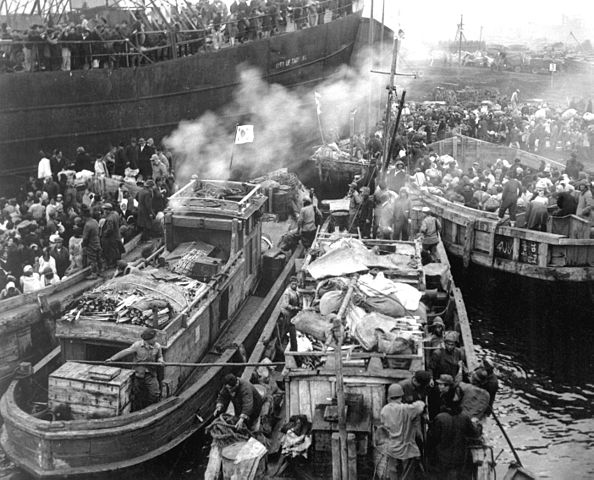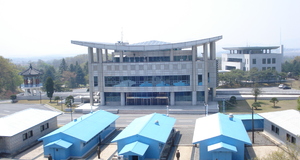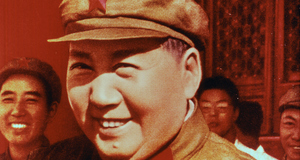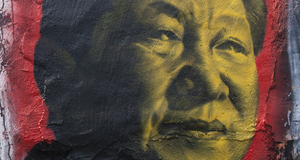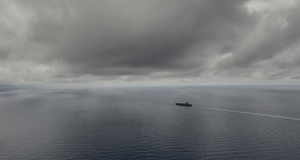Allison, Graham. Essence of Decision: Explaining the Cuban Missile Crisis. New York: HarperCollins, 1971.
Bai, Fan. “Siwang xianshang zhengzha de beihan xiaonanmin” (The deathly struggle of North Korean refugees), Epoch Times, June 14, 2009. Accessed August 21, 2012. http://www.epochtimes.com/gb/9/6/12/n2555767.htm.
Betts, Alexander and Gil Loescher, ed. Refugees in International Relations. New York: Oxford University Press, 2011.
---. “Refugees in International Relations.” In Refugees in International Relations, edited by Alexander Betts and Gil Loescher, 1-27. New York: Oxford University Press, 2011.
Bourne, James. “No Assistance for Kachin Refugees.” Radio Free Asia, June 26, 2012. Accessed July 19, 2012. http://www.rfa.org/english/news/burma/refugees-06262012165817.html/.
Branigan, Tania. “Burma’s military junta accused of torturing and killing ethnic rebels.” The Guardian, December 18, 2011. Accessed July 18, 2012. http://www.guardian.co.uk/world/2011/dec/18/burma-military-junta-kachin-rebels.
Byman, Daniel L. and Kenneth M. Pollack. “Let Us Now Praise Great Men: Bringing the Statesman Back In.” International Security 25:4 (2001): 107-146.
Cai, Jian. “The Korea Nuclear Crisis: The Changing Sino-DPRK Relationship.” Asian Perspective 34:1 (2010): 137-158.
Chan, Royston. “China tents dismantled as refugees return to Myanmar.” Reuters, September 1, 2009. Accessed July 25, 2012. http://uk.reuters.com/article/2009/09/01/uk-china-myanmar-sb-idUKTRE5800WI20090901.
Chang, C. Y. “Overseas Chinese in China’s Policy.” The China Quarterly 82 (June 1980): 281-303.
Charney, Michael. “U Nu, China and the ‘Burmese’ Cold War: Propaganda in Burma in the 1950s.” In The Cold War in Asia: The Battle for Hearts and Minds, edited by Zheng Yangwen, Hong Liu and Michael Szonyi, 41-58. Boston: Brill, 2010.
Checkel, Jeffrey T. “Constructivism and foreign policy.” In Foreign Policy: theories, actors, cases, edited by Steve Smith, Amelia Hadfield and Tim Dunne, 71-82. New York: Oxford University Press, 2008.
Chen, Jian. “China and the First Indo-China War, 1950-54.” The China Quarterly 133 (1993): 85-110.
---. “China’s Involvement in the Vietnam War, 1964-69.” The China Quarterly 142 (June 1995): 356-387.
Cheng, Xiaohe. “The Evolution of Sino-North Korean Relations in the 1960s.” Asian Perspective 34:2 (2010): 173-199.
“China accused of forcing Burma refugees back to war zone.” The Guardian, June 26, 2012. Accessed July 18, 2012. http://www.guardian.co.uk/world/2012/jun/26/china-accused-returning-burma-refugees.
“China building North Korea fence.” Taipei Times, October 18, 2006. Accessed August 17, 2012. http://www.taipeitimes.com/News/world/archives/2006/10/18/2003332245.
Chiu, Hungdah. “China’s Legal Position on Protecting Chinese Residents in Vietnam.” The American Journal of International Law 74:3 (1980): 685-689.
Donnell, John C. “Vietnam 1979: Year of Calamity.” Asian Survey 20:1 (1980): 19-32.
Doyle, Michael W. “Liberalism and foreign policy.” In Foreign Policy: theories, actors, cases, edited by Steve Smith, Amelia Hadfield and Tim Dunne, 49-70. New York: Oxford University Press, 2008.
Ganesan, N. “Myanmar-China Relations: Interlocking Interests but Independent Output.” Japanese Journal of Political Science 12:1 (2011): 95-111.
Goma, Daniel. “The Chinese-Korean Border Issue: An Analysis of a Contested Frontier.” Asian Survey 46:6 (2006): 867-880.
Guo, Ming. Zhong Yue guanxi yanbian sishinian (The Evolution of Sino-Vietnamese Relations over the Past Forty Years). Nanning, China: Guangxi renmin chubanshe, 1992.
Fan, Hongwei. “Sino-Burmese Relations 1949-1953.” In China in the World: Contemporary Issues and Perspectives, edited by Emile Kok-Kheng Yeoh and Joanne Hoi-Lee Loh, 70-84. Kuala Lumpur: Institute of China Studies, 2008.
Fan, Shouyi, trans. “Jilaizhi, zeanzhi: 20 wan yuenan nanmin zai zhongguo shengcun diaocha” (Now that they have come, we must help them settle down: an investigation of the living conditions of 200,000 Vietnamese refugees in China). China Academic Journal Electronic Publishing House (2007): 13-15.
Forced Migration Online. “What is forced migration?” Last modified January 27, 2012. Accessed July 15, 2012. http://www.forcedmigration.org/about/whatisfm/what-is-forced-migration/.
Fuller, T. “Refugees Flee to China as Fighting Breaks Out in Myanmar.” New York Times, August 29th, 2009.
Haggard, Stephan and Marcus Noland. Witness to Transformation: Refugee Insights into North Korea. Washington, DC: Peter G. Peterson Institute for International Economics, 2011.
Harden, Blaine. Escape from Camp 14: One Man’s Remarkable Odyssey from North Korea to Freedom in the West. London: The Penguin Group, 2012.
Halperin, Morton H. Bureaucratic Politics and Foreign Policy. Washington, DC: The Brookings Institution, 1974.
Hudson, Valerie M. “The History and Evolution of Foreign Policy Analysis.” In Foreign Policy: theories, actors, cases, edited by Steve Smith, Amelia Hadfield and Tim Dunne, 11-29. New York: Oxford University Press, 2008.
Human Rights Watch. “The Invisible Exodus: North Korean in the PRC.” November 2002, 14:8 (C). http://www.hrw.org/reports/2002/northkorea/.
“Hydropower Dams Fuelling Conflict in Burma.” Burma Rivers Network, June 15, 2011. Accessed July 24, 2012. http://www.burmapartnership.org/2011/06/hydropower-dams-fuelling-conflict-in-burma/.
Jagan, Larry. “Border war rattles China-Myanmar ties.” Asia Times, September 1, 2009. Accessed July 25, 2012. http://www.atimes.com/atimes/Southeast_Asia/KI01Ae04.html.
Keely, Charles B. “How Nation-States Create and Respond to Refugee Flows.” International Migration Review 30:4 (Winter 1996): 1046-1066.
Kim, Hyeungkyu. “From a buffer zone to a strategic burden: evolving Sino-North Korea relations during the Hu Jintao era.” The Korean Journal of Defence Analysis 22:1 (2010): 57-74.
“Kim Jong-un meets with senior Chinese officials.” The Telegraph, August 3, 2012. Accessed August 16, 2012. http://www.telegraph.co.uk/news/worldnews/asia/northkorea/9448404/Kim-Jong-un-meets-with-senior-Chinese-officials.html.
Kim, Taekyoon. “Strategizing aid: US-China food aid relations to North Korea in the 1990s.” International Relations of Asia-Pacific 12 (2012): 41-70.
Ko, Htwe. “Chinese authorities push Kachin refugees back into Burma.” Democratic Voice of Burma, July 18, 2012. Accessed July 18, 2012. http://www.dvb.no/news/chinese-authorities-push-kachin-refugees-back-into-burma/22870.
Kraus, Charles. “A border region ‘exuded with militant friendship’: Provincial narratives of China’s participation in the First Indochina War, 1949-1954.” Cold War History 12:3 (2011): 495-514.
Kurlantzick, Joshua. “Myanmar: The Next Failed State?” Current History 110:737 (2011): 242-248.
Lam, Tom. “The Exodus of Hoa Refugees from Vietnam and their Settlement in Guangxi: China’s Refugee Settlement Strategies.” Journal of Refugee Studies 13:4 (2000): 374-390.
Lee, Keumsoon. The Border-crossing North Koreans: Current Situations and Future Prospects. Korea Institute for National Unification, 2006.
Lintner, Bertil. “Realpolitik and the Myanmar Spring.” Foreign Policy, November 30, 2011. Accessed July 24, 2012. http://www.foreignpolicy.com/articles/2011/11/30/democracy_myanmar_china_clinton?page=0,1.
Lischer, Sarah Kenyon. Dangerous Sanctuaries: Refugee Camps, Civil War, and the Dilemma of Humanitarian Aid. New York: Cornell University Press, 2005.
Liu, Ming. “China and the North Korean Crisis: Facing Test and Transition.” Pacific Affairs 76:3 (2003): 347-373.
Locke, John. Two Treatises of Civil Government. New York: Everyman’s Library, 1924.
Loescher, Gil. “Introduction.” In Refugee and International Relations, edited by Gil Loescher and Laila Monahan, 1-33. New York: Oxford University Press, 1989.
McCarthy,Thomas. “China and North Korean ‘Refugees’.” Special Report, Northeast Asia Peace and Security Network (2002).
McGowan, P. and H. B. Shapiro. The Comparative Study of Foreign Policy: A Survey of Scientific Findings. Beverly Hills, CA: Sage, 1973.
Ministry of Commerce, People’s Republic of China. “Trade with Countries and Regions in Asia (2010/01-04).” Last modified May 26, 2010. Accessed August 16, 2012. http://english.mofcom.gov.cn/aarticle/statistic/lanmubb/ASEAN/201005/20100506934001.html.
Moregnthau, Han. Politics Among Nations. New York: The McGraw-Hill Companies, 1948.
“Myanmar border inhabitants begin to return from China as situation calms.” Xinhua News, August 30, 2009. Accessed July 25, 2012. http://news.xinhuanet.com/english/2009-08/30/content_11966205.htm.
“Myanmar fighters cross into China.” Al Jazeera, August 30, 2009. Accessed July 25, 2012. http://www.aljazeera.com/news/asia-pacific/2009/08/20098306161918344.html.
Myint-U, Thant. Where China Meets India. New York: Farrar, Straus and Giroux, 2011.
“North Korea’s Kim Jong-un may be planning first China trip.” The Telegraph, July 31, 2012. Accessed August 16, 2012. http://www.telegraph.co.uk/news/worldnews/asia/northkorea/9440146/North-Koreas-Kim-Jong-un-may-be-planning-first-China-trip.html.
Owen, Norman G. et al., “Burma becomes Myanmar.” In The Emergence of Modern Southeast Asia, edited by Norman G. Owen et al., 497-506. Honolulu: University of Hawaii Press, 2005.
Path, Kosal. “The economic factor in the Sino-Vietnamese split, 1972-75: An analysis of Vietnamese archival sources.” Cold War History 11:4 (2011): 519-555.
Poon, Kim Shee. “The Political Economy of China-Myanmar Relations: Strategic and Economic Dimensions.” Ritsumeikan Annual Review of International Studies 1 (2002): 33-53.
Qu, Aiguo. “Chinese supporters in the operations to assist Vietnam and resist America.” Paper presented at the “International Workshop on New Evidence on China, Southeast Aisa and the Vietnam War,” Hong Kong, January 11-12, 2000.
“Refugees of Rhetoric Victims in a neighbourly conflict.” Time Magazine 112:6, August 7, 1978.
Rose, Gideon. “Neoclassical Realism and Theories of Foreign Policy.” World Politics 51:1 (October 1998): 144-172.
Scalapino, Robert. “China and Korean reunification – a neighbour’s concerns.” In Korea’s Future and the Great Powers, edited by Nicholas Eberstadt and Richard J. Ellings, 107-124. Seattle, WA: University of Washington Press, 2001.
“Seoul urges China on North Korea refugees.” BBC News, February 22, 2012. Accessed August 21, 2012. http://www.bbc.co.uk/news/world-asia-17123208.
Smith, Matthew F. “Isolated in Yunnan: Kachin Refugees from Burma in China’s Yunnan Province.” Human Rights Watch (June 2012). http://www.hrw.org/sites/default/files/reports/china0612_forinsertForUpload.pdf.
Snyder, Jack. “Realism, Refugees, and Strategies of Humanitarianism.” In Refugees in International Relations, edited by Alexander Betts and Gil Loescher, 29-52. New York: Oxford University Press, 2011.
Snyder, Richard C., H.W. Bruck, and Burton Sapin. Decision-Making as an Approach to the Study of International Politics. Princeton: Princeton University, Organizational Behaviour Section, 1954.
Stedman, Stephen John and Fred Tanner. Refugee Manipulation: War, Politics, and the Abuse of Human Suffering. Washington, DC: The Brookings Institution, 2003.
Storey, Ian. “Emerging Fault Lines in Sino-Burmese Relations: The Kokang Incident.” China Brief 9:18 (2009): 5-8.
Teitelbaum, Michael S. “Immigration, refugees, and foreign policy.” International Organization 38:3 (Summer 1984): 429-50.
United Nations General Assembly. “Situation of human rights in Myanmar.” Last modified March 13, 2007. Accessed August 21, 2012. http://daccess-dds-ny.un.org/doc/UNDOC/GEN/N06/508/29/PDF/N0650829.pdf?OpenElement.
United Nations High Commissioner for Refugees. “Convention and Protocol Relating to the Status of Refugees.” Geneva, 1967. Accessed August 22, 2012, http://www.unhcr.org/3b66c2aa10.html.
United Nations High Commissioner for Refugees. “North Koreans in China: UNHCR asks for access.” Last modified January 21, 2003. Accessed August 16, 2012. http://www.unhcr.org/3e2d3f98f.html.
United Nations Security Council. “Security Council Fails to Adopt Draft Resolution on Myanmar Owing to Negative Votes by China, Russia Federation.” Last modified January 12, 2007. Accessed August 21, 2012. http://www.un.org/News/Press/docs/2007/sc8939.doc.htm.
United States Citizenship and Immigration Services. “23.6 Refugee and Asylee Adjustment under Section 209 of the Act.” Last modified June 21, 2006. Accessed August 22, 2012. http://www.uscis.gov/ilink/docView/AFM/HTML/AFM/0-0-0-1/0-0-0-8624/0-0-0-9785.html.
Wain, Barry. “The Indochina Refugee Crisis.” Foreign Affairs 58:1 (1979): 160-180.
Watts, Jonathan. “Dozens killed in Burma amid clashes over Chinese dams.” The Guardian, June 16, 2011. Accessed July 24, 2012. http://www.guardian.co.uk/world/2011/jun/16/china-burma-hydropower-clashes.
Weiner, Myron. “The Clash of Norms – Dilemmas in Refugee Policies.” Journal of Refugee Studies 11:4 (1998): 433-453.
Wohlforth, William C. “Realism and foreign policy.” In Foreign Policy: theories, actors, cases, edited by Steve Smith, Amelia Hadfield and Tim Dunne, 31-48. New York: Oxford University Press, 2008.
Zhai, Qiang. China and the Vietnam Wars, 1950-1965. Chapel Hill: The University of North Carolina Press, 2000.
Zhan, Debin. “Chinese People’s Understanding of the Korean Unification Issue.” Asian Social Science 8:3 (2012): 63-74.
Zhang, Xiaoming. “China’s 1979 War with Vietnam: A Reassessment.” The China Quarterly 184 (December 2005): 851-874.
“Zhonghua renmin gongheguo he Chaoxian minzhu zhuyi renmin gongheguo zhengfu lianhe gongbao” (Joint Communiqué of the People’s Republic and the Government of the Democratic People’s Republic of Korea). People’s Daily, April 9th, 1970.
Zolberg, Aristide R., Astri Suhrke and Sergio Aguayo. “International Factors in the Formation of Refugee Movements.” International Migration Review 20:2 (Summer 1986): 151-169.
Endnotes
1.) Valerie M. Hudson, “The History and Evolution of Foreign Policy Analysis,” in Foreign Policy: theories, actors, cases, ed. Steve Smith, Amelia Hadfield and Tim Dunne (New York: Oxford University Press, 2008), 12.
2.) For foreign policy decision-making, see Richard C. Snyder, H.W. Bruck, and Burton Sapin, Decision-Making as an Approach to the Study of International Politics (Princeton: Princeton University, Organizational Behaviour Section, 1954). For bureaucratic and organizational politics, see Graham Allison, Essence of Decision: Explaining the Cuban Missile Crisis (New York: HarperCollins, 1971); Morton H. Halperin, Bureaucratic Politics and Foreign Policy (Washington, DC: The Brookings Institution, 1974). For psychological analyses, see Daniel L. Byman and Kenneth M. Pollack, “Let Us Now Praise Great Men: Bringing the Statesman Back In,” International Security 25:4 (2001): 107-146. For comparative foreign policy, see P. McGowan and H. B. Shapiro, The Comparative Study of Foreign Policy: A Survey of Scientific Findings (Beverly Hills, CA: Sage, 1973).
3.) See chapters William C. Wohlforth, “Realism and foreign policy”; Michael W. Doyle, “Liberalism and foreign policy;” Jeffrey T. Checkel, “Constructivism and foreign policy,” in Foreign Policy: theories, actors, cases, ed. Steve Smith, Amelia Hadfield and Tim Dunne (New York: Oxford University Press, 2008), 31-82.
4.) See Gideon Rose, “Neoclassical Realism and Theories of Foreign Policy,” World Politics 51:1 (October 1998): 144-172.
5.) Hudson, 27.
6.) Aristide R. Zolberg, Astri Suhrke and Sergio Aguayo, “International Factors in the Formation of Refugee Movements,” International Migration Review 20:2 (Summer 1986): 155.
7.) Ibid.
8.) Michael S. Teitelbaum, “Immigration, refugees, and foreign policy,” International Organization 38:3 (Summer 1984): 429-50.
9.) Ibid, 437-9.
10.) Gil Loescher, “Introduction,” in Refugee and International Relations, ed. Gil Loescher and Laila Monahan (New York: Oxford University Press, 1989), 12.
11.) Alexander Betts and Gil Loescher, ed. Refugees in International Relations. New York: Oxford University Press, 2011.
12.) Alexander Betts and Gil Loescher, “Refugees in International Relations,” in Refugees in International Relations, ed. Alexander Betts and Gil Loescher (New York: Oxford University Press, 2011), 3.
13.) Jack Snyder, “Realism, Refugees, and Strategies of Humanitarianism,” in Refugees in International Relations, ed. Alexander Betts and Gil Loescher (New York: Oxford University Press, 2011), 29.
14.) Myron Weiner, “The Clash of Norms – Dilemmas in Refugee Policies,” Journal of Refugee Studies 11:4 (1998): 433.
15.) Snyder, “Realism,” 32.
16.) Stephen John Stedman and Fred Tanner, Refugee Manipulation: War, Politics, and the Abuse of Human Suffering (Washington, DC: The Brookings Institution, 2003).
17.) Sarah Kenyon Lischer, Dangerous Sanctuaries: Refugee Camps, Civil War, and the Dilemma of Humanitarian Aid (New York: Cornell University Press, 2005).
18.) See John Locke, Two Treatises of Civil Government (New York: Everyman’s Library, 1924); Hans Moregnthau, Politics Among Nations (New York: The McGraw-Hill Companies, 1948).
19.) “Convention and Protocol relating to the Status of Refugees,” United Nations High Commissioner for Refugees (Geneva: 1967), accessed August 22, 2012, http://www.unhcr.org/3b66c2aa10.html.
20.) Charles B. Keely, “How Nation-States Create and Respond to Refugee Flows,” International Migration Review 30:4 (Winter 1996): 1057.
21.) Loescher, 17.
22.) Ibid.
23.) Betts and Loescher, 9.
24.) Ibid, 2.
25.) Ming Liu, “China and the North Korean Crisis: Facing Test and Transition,” Pacific Affairs 76:3 (2003): 348.
26.) China has exerted 2000 years of influence on Korea. Up until 1910, China carried out the role as a patron under a feudal regime, assisting Korea in the development of its political and cultural civilization. See Debin Zhan, “Chinese People’s Understanding of the Korean Unification Issue,” Asian Social Science 8:3 (2012): 64.
27.) Jian Cai, “The Korea Nuclear Crisis: The Changing Sino-DPRK Relationship,” Asian Perspective 34:1 (2010): 152.
28.) Xiaohe Cheng, “The Evolution of Sino-North Korean Relations in the 1960s,” Asian Perspective 34:2 (2010): 176.
29.) Hyeungkyu Kim, “From a buffer zone to a strategic burden: evolving Sino-North Korea relations during the Hu Jintao era,” The Korean Journal of Defence Analysis 22:1 (2010): 59.
30.) Cheng, 180.
31.) Zhan, 57.
32.) Cheng, 191.
33.) Daniel Goma, “The Chinese-Korean Border Issue: An Analysis of a Contested Frontier,” Asian Survey 46:6 (2006): 875.
34.) Cheng, 191-2.
35.) “Zhonghua renmin gongheguo he Chaoxian minzhu zhuyi renmin gongheguo zhengfu lianhe gongbao” (“Joint Communiqué of the People’s Republic and the Governmnet of the Democratic People’s Republic of Korea”), People’s Daily, April 9th, 1970.
36.) Taekyoon Kim, “Strategizing aid: US-China food aid relations to North Korea in the 1990s,” International Relations of Asia-Pacific 12 (2012): 55.
37.) Kim, “Strategizing aid,” 56.
38.) Liu, 363-4.
39.) China avoided participation in 1994 because Sino-United States and Sino-North Korean relations were at low-points in the 1990s. Following the Tianamen incident in 1989, United States condemned China for its actions and imposed sanctions. Strained Sino-North Korean relations are described above.
40.) Liu, 347.
41.) Kim, “From a buffer zone,” 66.
42.) See Robert Scalapino, “China and Korean reunification – a neighbour’s concerns,” in Korea’s Future and the Great Powers, ed. Nicholas Eberstadt and Richard J. Ellings (Seattle, WA: University of Washington Press, 2001), 107-124.
43.) Stephan Haggard and Marcus Noland, Witness to Transformation: Refugee Insights into North Korea (Washington, DC: Peter G. Peterson Institute for International Economics, 2011), 30.
44.) Ibid.
45.) Blaine Harden, Escape from Camp 14: One Man’s Remarkable Odyssey from North Korea to Freedom in the West (London: The Penguin Group, 2012), 38.
46.) Keumsoon Lee, The Border-crossing North Koreans: Current Situations and Future Prospects (Korea Institute for National Unification, 2006),10-11.
47.) Ibid, 11.
48.) Human Rights Watch, “The Invisible Exodus: North Korean in the PRC,” November 2002, 14:8 (C), http://www.hrw.org/reports/2002/northkorea/.
49.) Haggard and Noland, 28.
50.) Fan Bai, “Siwang xianshang zhengzha de beihan xiaonanmin” (“The deathly struggle of North Korean refugees”), Epoch Times, June 14, 2009, accessed August 21, 2012, http://www.epochtimes.com/gb/9/6/12/n2555767.htm.
51.) Human Rights Watch.
52.) “China building North Korea fence,” Taipei Times, October 18, 2006, accessed August 17, 2012, http://www.taipeitimes.com/News/world/archives/2006/10/18/2003332245.
53.) Liu, 352.
54.) Human Rights Watch.
55.) Liu, 354.
56.) See Thomas McCarthy,“China and North Korean ‘Refugees’,” Special Report, Northeast Asia Peace and Security Network (2002); Liu, 353.
57.) Lee, 41.
58.) Ibid, 42.
59.) Human Rights Watch.
60.) Bai.
61.) Ibid.
62.) Most recently, China is in process of repatriating up to 30 North Koreans who had been arrested. See “Seoul urges China on North Korea refugees,” BBC News, February 22, 2012, accessed August 21, 2012, http://www.bbc.co.uk/news/world-asia-17123208.
63.) The paper will use the name “Burma” (Union of Burma) until the paper begins to discuss the time period after 2008, the year when the Burma changed its official name to Republic of the Union of Myanmar.
64.) Hongwei Fan, “Sino-Burmese Relations 1949-1953,” in China in the World: Contemporary Issues and Perspectives, ed. Emile Kok-Kheng Yeoh and Joanne Hoi-Lee Loh (Kuala Lumpur: Institute of China Studies, 2008), 80.
65.) Ibid, 77.
66.) Michael Charney, “U Nu, China and the ‘Burmese’ Cold War: Propaganda in Burma in the 1950s,” in The Cold War in Asia: The Battle for Hearts and Minds, ed. Zheng Yangwen, Hong Liu and Michael Szonyi (Boston: Brill, 2010), 42.
67.) Joshua Kurlantzick, “Myanmar: The Next Failed State?” Current History 110:737 (2011): 242.
68.) Norman G. Owen et al., “Burma becomes Myanmar,” in The Emergence of Modern Southeast Asia, ed. Norman G. Owen et al. (Honolulu: University of Hawaii Press, 2005), 500.
69.) N. Ganesan, “Myanmar-China Relations: Interlocking Interests but Independent Output,” Japanese Journal of Political Science 12:1 (2011): 107.
70.) Thant Myint-U, Where China Meets India (New York: Farrar, Straus and Giroux, 2011), 141.
71.) Ibid, 131.
72.) Ganesan, 107.
73.) Ian Storey, “Emerging Fault Lines in Sino-Burmese Relations: The Kokang Incident,” China Brief 9:18 (2009): 6.
74.) Owen et al., 500.
75.) Myint-U, 51.
76.) Ibid, 52.
77.) Ibid, 51.
78.) Poon Kim Shee, “The Political Economy of China-Myanmar Relations: Strategic and Economic Dimensions,” Ritsumeikan Annual Review of International Studies 1 (2002): 34.
79.) From 1962 to 1988, the Ne Win regime of the Burma Socialist Programme Party dominated and pursued socialist policies to develop the country. However, these policies failed to vitalize the economy, and instead plunged Burma into poverty. The state had to rely on authoritarianism to control its citizens. The legacy of totalitarianism remained and Burma has long been criticized for its human rights abuses. Between 1989-1999, multi-party elections were held. This captured the international community’s attention, as Burmese-born, British-National Aung Yang Suu Kyi returned to Burma to lead the democratic movement. However, when the Democratic Party won the elections, the results were ignored. Popular protests against these actions, known infamously as the 8888 Uprising (on August 8th, 1988), were later violently crushed. The military swept in and established the State Law and Order Restoration Council (SLORC). Since then, Burma has been in the international limelight for its undemocratic practices and human rights abuses. Consequently, economic, political sanctions and isolation from the international community persisted. Nonetheless, in 2003, General and Prime Minister Khin Nyunt announced a 7-step “roadmap” to “disciplined democracy.”
80.) Owen et al., 504.
81.) Storey, 6.
82.) Kurlantzick, 245.
[83] Bertil Lintner, “Realpolitik and the Myanmar Spring,” Foreign Policy, November 30, 2011, accessed July 24, 2012,
http://www.foreignpolicy.com/articles/2011/11/30/democracy_myanmar_china_clinton?page=0,1.
84.) Ibid, 2.
85.) Myint-U, 72.
86.) Lintner, 2.
87.) “Security Council Fails to Adopt Draft Resolution on Myanmar Owing to Negative Votes by China, Russia Federation,” United Nations Security Council, last modified January 12, 2007, accessed August 21, 2012, http://www.un.org/News/Press/docs/2007/sc8939.doc.htm.
88.) Larry Jagan, “Border war rattles China-Myanmar ties,” Asia Times, September 1, 2009, accessed July 25, 2012, http://www.atimes.com/atimes/Southeast_Asia/KI01Ae04.html.
89.) Ibid. Tensions had been building up prior to the attack, as Myanmar troops began to take up positions in the Kokang area in early August. In April 2009, the Burmese government demanded ethnic militias, including the Kokang Myanmar National Democratic Alliance Army (MNDAA), United Wa Sate Army, and the Kachin Independence Army (KIA), to disarm or to convert into Border Guard Forces under the command of the Tatmadaw. However, these groups rejected these demands, in fear of losing their autonomy and business interests, as the 1989 ceasefire agreements have allowed them to maintain control over their territory. Earlier in August, the three groups, along with the Kachin Independence Army (KIA) formed an alliance – the Myanmar Peace and Democracy Front – and agreed to not surrender their arms before elections in 2010. On the other hand, for the Burmese government, the elections gave it incentive to demonstrate military victory and authority across the country. To justify the attack, the government claimed that their operation was a drug raid. Effectively, renewed fighting broke two decades of ceasefire.
90.) T. Fuller, “Refugees Flee to China as Fighting Breaks Out in Myanmar,” New York Times, August 29th, 2009.
91.) “Myanmar fighters cross into China,” Al Jazeera, August 30, 2009, accessed July 25, 2012, http://www.aljazeera.com/news/asia-pacific/2009/08/20098306161918344.html.
92.) Jagan.
93.) Royston Chan, “China tents dismantled as refugees return to Myanmar,” Reuters, September 1, 2009, accessed July 25, 2012, http://uk.reuters.com/article/2009/09/01/uk-china-myanmar-sb-idUKTRE5800WI20090901.
94.) “Myanmar border inhabitants begin to return from China as situation calms,” Xinhua News, August 30, 2009, accessed July 25, 2012, http://news.xinhuanet.com/english/2009-08/30/content_11966205.htm.
95.) Chan.
[96] Tania Branigan, “Burma’s military junta accused of torturing and killing ethnic rebels,” The Guardian, December 18, 2011, accessed July 18, 2012, http://www.guardian.co.uk/world/2011/dec/18/burma-military-junta-kachin-rebels.
[97] See Jonathan Watts, “Dozens killed in Burma amid clashes over Chinese dams,” The Guardian, June 16, 2011, accessed July 24, 2012, http://www.guardian.co.uk/world/2011/jun/16/china-burma-hydropower-clashes; “Hydropower Dams Fuelling Conflict in Burma,” Burma Rivers Network, June 15, 2011, accessed July 24, 2012, http://www.burmapartnership.org/2011/06/hydropower-dams-fuelling-conflict-in-burma/.
98.) “Hydropower Dams Fuelling Conflict in Burma.”
99.) James Bourne, “No Assistance for Kachin Refugees,” Radio Free Asia, June 26, 2012, accessed July 19, 2012, http://www.rfa.org/english/news/burma/refugees-06262012165817.html/.
100.) Matthew F. Smith, “Isolated in Yunnan: Kachin Refugees from Burma in China’s Yunnan Province,” Human Rights Watch (June 2012).
[101] Branigan.
[102] Bourne.
[103] “China accused of forcing Burma refugees back to war zone,” The Guardian, June 26, 2012, accessed July 18, 2012, http://www.guardian.co.uk/world/2012/jun/26/china-accused-returning-burma-refugees.
[104] Htwe Ko, “Chinese authorities push Kachin refugees back into Burma,” Democratic Voice of Burma, July 18, 2012, accessed July 18, 2012, http://www.dvb.no/news/chinese-authorities-push-kachin-refugees-back-into-burma/22870.
105.) “China accused of forcing Burma refugees back to war zone.”
106.) See Jian Chen, “China and the First Indo-China War, 1950-54,” The China Quarterly 133 (1993): 106; Qiang Zhai, China and the Vietnam Wars, 1950-1965 (Chapel Hill: The University of North Carolina Press, 2000), 6.
107.) Charles Kraus, “A border region ‘exuded with militant friendship’: Provincial narratives of China’s participation in the First Indochina War, 1949-1954,” Cold War History 12:3 (2011): 495. After the First Indochina War, the Geneva Conference held on July 21, 1954 divided Vietnam at the 17th parallel. The north of the parallel was under control of the Viet Minh as the Democratic Republic of Vietnam, while the south became the State of Vietnam. As stipulated at the Geneva Conference, this provisional division was to be upheld until nationwide elections are held in 1956.
108.) Jian Chen, “China’s Involvement in the Vietnam War, 1964-69,” The China Quarterly 142 (June 1995): 356.
109.) Ming Guo, Zhong Yue guanxi yanbian sishinian (The Evolution of Sino-Vietnamese Relations over the Past Forty Years) (Nanning, China: Guangxi renmin chubanshe, 1992), 53.
110.) Chen, “China and the First Indo-China War,” 106.
111.) Ibid, 107-8.
112.) Kosal Path, “The economic factor in the Sino-Vietnamese split, 1972-75: An analysis of Vietnamese archival sources,” Cold War History 11:4 (2011): 519.
113.) Chen, “China’s Involvement,” 358.
114.) Ibid, 359.
115.) Aiguo Qu, “Chinese supporters in the operations to assist Vietnam and resist America” (paper presented at the “International Workshop on New Evidence on China, Southeast Aisa and the Vietnam War,” Hong Kong, January 11-12, 2000): 40.
116.) Chen, “China’s Involvement,” 371.
117.) Ibid, 370.
118.) Ibid, 386.
119.) Path, 522.
120.) First, China was experiencing domestic hardship resulting from the failure of the Cultural Revolution of 1966, which limited China’s capacity to provide the large-scale assistance it was able to before. Second, declining threat from the United States led to President Nixon’s visit to China in 1972. Third, after the Sino-Soviet split, containing Soviet influence in the region became tantamount. It was thus essential to pull Vietnam away from Soviet’s orbit of influence.
121.) Path, 529.
122.) Ibid, 530.
123.) Xiaoming Zhang, “China’s 1979 War with Vietnam: A Reassessment,” The China Quarterly 184 (December 2005): 855.
124.) Path, 540.
125.) John C. Donnell, “Vietnam 1979: Year of Calamity,” Asian Survey 20:1 (1980): 22.
126.) Zhang, 865.
127.) Ibid, 853.
128.) Ibid, 867.
129.) Barry Wain, “The Indochina Refugee Crisis,” Foreign Affairs 58:1 (1979): 161.
130.) Hungdah Chiu, “China’s Legal Position on Protecting Chinese Residents in Vietnam,” The American Journal of International Law 74:3 (1980): 685.
131.) Wain, 163.
132.) Ibid, 163-4.
133.) Donnell, 27.
134.) Wain, 171.
135.) Ibid, 164.
136.) Ibid, 172.
137.) “Refugees of Rhetoric Victims in a neighbourly conflict,” Time Magazine 112:6, August 7, 1978, 52.
138.) Wain, 166.
139.) Shouyi Fan, trans., “Jilaizhi, zeanzhi: 20 wan yuenan nanmin zai zhongguo shengcun diaocha” (Now that they have come, we must help them settle down: an investigation of the living conditions of 200,000 Vietnamese refugees in China), China Academic Journal Electronic Publishing House 12 (2007): 15. Office of UNHCR “highly acclaimed the Chinese government’s efforts to make arrangements for settling the refugees in China,” and stated that the “placement of Vietnamese refugees within its borders is one of the most successful models for settlement of refugees.”
140.) Tom Lam, “The Exodus of Hoa Refugees from Vietnam and their Settlement in Guangxi: China’s Refugee Settlement Strategies,” Journal of Refugee Studies 13:4 (2000): 378.
141.) Ibid.
142.) Ibid.
143.) Ibid, 379.
144.) Ibid, 389.
145.) Ibid, 384-386.
146.) “North Koreans in China: UNHCR asks for access,” United Nations High Commissioner for Refugees, last modified January 21, 2003, accessed August 16, 2012, http://www.unhcr.org/3e2d3f98f.html.
147.) “Trade with Countries and Regions in Asia (2010/01-04),” Ministry of Commerce, People’s Republic of China, last modified May 26, 2010, accessed August 16, 2012, http://english.mofcom.gov.cn/aarticle/statistic/lanmubb/ASEAN/201005/20100506934001.html.
148.) Ibid.
149.) C. Y. Chang, “Overseas Chinese in China’s Policy,” The China Quarterly 82 (June 1980): 283.
150.) Chiu, 688.
151.) See “Kim Jong-un meets with senior Chinese officials,” The Telegraph, August 3, 2012, accessed August 16, 2012, http://www.telegraph.co.uk/news/worldnews/asia/northkorea/9448404/Kim-Jong-un-meets-with-senior-Chinese-officials.html; “North Korea’s Kim Jong-un may be planning first China trip,” The Telegraph, July 31, 2012, accessed August 16, 2012, http://www.telegraph.co.uk/news/worldnews/asia/northkorea/9440146/North-Koreas-Kim-Jong-un-may-be-planning-first-China-trip.html.
152.) “Situation of human rights in Myanmar,” United Nations General Assembly, last modified March 13, 2007, accessed August 21, 2012, http://daccess-dds-ny.un.org/doc/UNDOC/GEN/N06/508/29/PDF/N0650829.pdf?OpenElement.
153.) Ganesan, 105.
154.) Ibid, 97.
155.) Betts and Loescher, “Refugees in International Relations,” 9.
156.) “23.6 Refugee and Asylee Adjustment under Section 209 of the Act,” United States Citizenship and Immigration Services, last modified June 21, 2006, accessed August 22, 2012, http://www.uscis.gov/ilink/docView/AFM/HTML/AFM/0-0-0-1/0-0-0-8624/0-0-0-9785.html.


